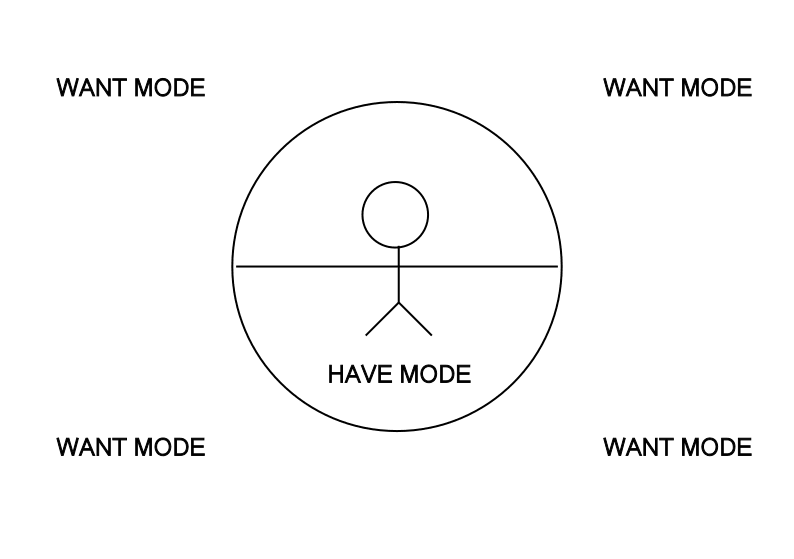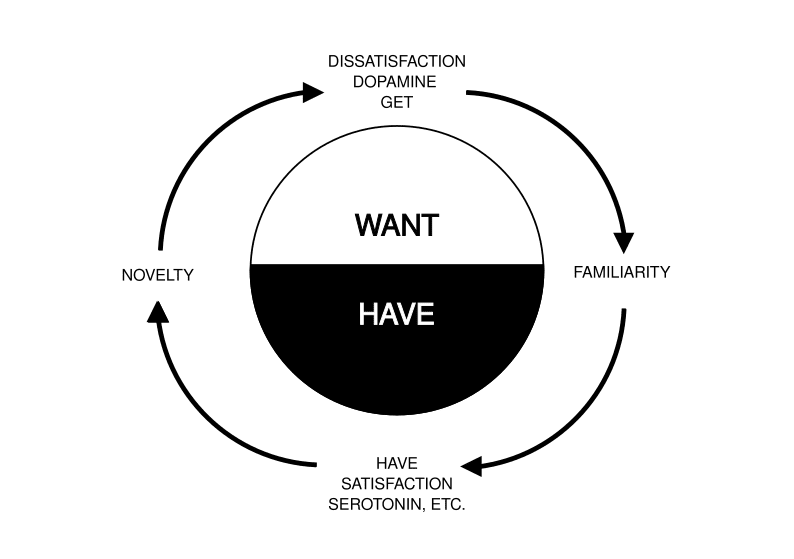sobercoach on Nostr: GET SOBER 04: MODE HAVE MODE WANT An individual’s state and possessions at any ...
GET SOBER 04: MODE HAVE MODE WANT
An individual’s state and possessions at any moment can be broken down using a very simple paradigm: the things that you have and the things that you don’t. It follows, then, that the brain has evolved two modes to operate for the purpose either of these conditions. They are literally different neural pathways: one mode operates in concern of the things you have, the other in concern of things you want. This extends beyond the physical, too. You might want to know or be able to do something, for example.
For simplicity, we’ll call these two modes “have” and “want.” In the following illustration, everything that falls inside the circle of the armspan is “have” mode, and anything outside is “want” mode.

And so by definition, the things you have are in the “now,” here in the present, whereas the things you want can only ever exist in the future. Only when it is the present can you finally have what you want, which consequently extinguishes the original desire. (In the meantime, you have to get up and make things happen.) Your brain and behaviour are therefore constantly switching between these modes in a delicate balancing act. For the alcohol dependent, you’ve fallen off both ends. The see-saw may have been rigged from the start, or it’s been damaged by daily use, but either way, you’re going to have to supervise until you can restore some kind of balance.
-A NEVER ENDING CYCLE
As a mental model, it’s easier to understand the process as a never-ending cycle. That’s how it is supposed to function, anyway. Sometimes there’s a glitch in the cycle, which is actually the crux of our problem, But let’s understand it as a functioning system first.

At any point in the cycle, we can only ever be operating in the “want” of “have” mode, and we continue to do so until the conditions arise to send us back into the other. And so we continue, going around in circles, flipping from one to the other.
-HAVE MODE
The “have” mode operates when we are engaged in the “here and now” with what we have. It is overseen by neurotransmitters, such as serotonin and endorphins, and what are known as endocannabinoids. (The details are not particularly important, rather the overall concept.) Because this mode of operation is configured for the present moment, the pathways and neurotransmitters facilitate a feeling of contentment and satisfaction, states which oppose mental projection into either the past of future. Examples of such might include being engaged in a good conversation or listening to a song that makes you forget yourself and time.
-WANT MODE
The “want” mode is very different and seemingly more complex. First and foremost, when this mode activates, it draws us out of the present and thrusts us mentally into a future projection of possibility. The “have” mode is stood down.
This mode is fuelled instead by the neurotransmitter dopamine. Dopamine has the exact opposite function to the apparatus of the “have” mode: it makes us dissatisfied with the “here and now,” and propels us toward a future outcome. For evolutionary purposes, this system gets us the resources we need for survival: food, reproduction, and so on. The resources we need, or perceive we need, in modern societies are, of course, much more complex.
Activation of this mode (release of dopamine) occurs when an element of novelty or deviation from the expected is identified in our physical or metal environment. Our subconscious continuously scans and maps our environment, and as soon as it identifies a contrast between the known and the unknown, a flag goes up. When we encounter something new or unexpected, it signifies possibility: the potential of resources directly, or the means to obtain or maximise resources indirectly. This is, of course, advantageous, and such circumstances set in motion the dopamine-driven functioning of the cycle. From here, alert and motivated, you investigate, strategise, and extract, where possible, what you can.
Once you have exhausted all possibility, and the new becomes the normal, the dopamine has done its job, the dopamine circuits shut down, and you’re returned to the “have” mode. Here you stay until you encounter the next deviation from the normal and are thrust into “want” mode again.
Imagine being lost in the desert, and you catch a glimmer of the sun’s reflection in what looks like water in the distance. Despite being tired and exhausted, you sprint as fast as you ever have and jump into crystal clear water when you arrive. You drink till your heart’s content and you can drink no more. The dopamine has done it’s job and you’ve secured a new resource. You know where it is now, and while you might need it gain, you’ll never sprint toward it like your life depends on it. That was the dopamine.
So how exactly is all this relevant to our situation? Well, as eluded to earlier, the system goes off the rails and we are the lucky ones who get stuck in "want" mode. A topic for next time...
But before I go, remember: working on sobriety is an iterative process. We never fail, only learn. Be kind to yourself and never give up.
Marky
#sobriety #sober #getsober #sobercoach #sobercoaching #sobrietycoach #sobrietycoaching #quitbooze #quitdrinking #stopdrinking #alcohol #alcoholfree #getsober04 #dopamine
An individual’s state and possessions at any moment can be broken down using a very simple paradigm: the things that you have and the things that you don’t. It follows, then, that the brain has evolved two modes to operate for the purpose either of these conditions. They are literally different neural pathways: one mode operates in concern of the things you have, the other in concern of things you want. This extends beyond the physical, too. You might want to know or be able to do something, for example.
For simplicity, we’ll call these two modes “have” and “want.” In the following illustration, everything that falls inside the circle of the armspan is “have” mode, and anything outside is “want” mode.

And so by definition, the things you have are in the “now,” here in the present, whereas the things you want can only ever exist in the future. Only when it is the present can you finally have what you want, which consequently extinguishes the original desire. (In the meantime, you have to get up and make things happen.) Your brain and behaviour are therefore constantly switching between these modes in a delicate balancing act. For the alcohol dependent, you’ve fallen off both ends. The see-saw may have been rigged from the start, or it’s been damaged by daily use, but either way, you’re going to have to supervise until you can restore some kind of balance.
-A NEVER ENDING CYCLE
As a mental model, it’s easier to understand the process as a never-ending cycle. That’s how it is supposed to function, anyway. Sometimes there’s a glitch in the cycle, which is actually the crux of our problem, But let’s understand it as a functioning system first.

At any point in the cycle, we can only ever be operating in the “want” of “have” mode, and we continue to do so until the conditions arise to send us back into the other. And so we continue, going around in circles, flipping from one to the other.
-HAVE MODE
The “have” mode operates when we are engaged in the “here and now” with what we have. It is overseen by neurotransmitters, such as serotonin and endorphins, and what are known as endocannabinoids. (The details are not particularly important, rather the overall concept.) Because this mode of operation is configured for the present moment, the pathways and neurotransmitters facilitate a feeling of contentment and satisfaction, states which oppose mental projection into either the past of future. Examples of such might include being engaged in a good conversation or listening to a song that makes you forget yourself and time.
-WANT MODE
The “want” mode is very different and seemingly more complex. First and foremost, when this mode activates, it draws us out of the present and thrusts us mentally into a future projection of possibility. The “have” mode is stood down.
This mode is fuelled instead by the neurotransmitter dopamine. Dopamine has the exact opposite function to the apparatus of the “have” mode: it makes us dissatisfied with the “here and now,” and propels us toward a future outcome. For evolutionary purposes, this system gets us the resources we need for survival: food, reproduction, and so on. The resources we need, or perceive we need, in modern societies are, of course, much more complex.
Activation of this mode (release of dopamine) occurs when an element of novelty or deviation from the expected is identified in our physical or metal environment. Our subconscious continuously scans and maps our environment, and as soon as it identifies a contrast between the known and the unknown, a flag goes up. When we encounter something new or unexpected, it signifies possibility: the potential of resources directly, or the means to obtain or maximise resources indirectly. This is, of course, advantageous, and such circumstances set in motion the dopamine-driven functioning of the cycle. From here, alert and motivated, you investigate, strategise, and extract, where possible, what you can.
Once you have exhausted all possibility, and the new becomes the normal, the dopamine has done its job, the dopamine circuits shut down, and you’re returned to the “have” mode. Here you stay until you encounter the next deviation from the normal and are thrust into “want” mode again.
Imagine being lost in the desert, and you catch a glimmer of the sun’s reflection in what looks like water in the distance. Despite being tired and exhausted, you sprint as fast as you ever have and jump into crystal clear water when you arrive. You drink till your heart’s content and you can drink no more. The dopamine has done it’s job and you’ve secured a new resource. You know where it is now, and while you might need it gain, you’ll never sprint toward it like your life depends on it. That was the dopamine.
So how exactly is all this relevant to our situation? Well, as eluded to earlier, the system goes off the rails and we are the lucky ones who get stuck in "want" mode. A topic for next time...
But before I go, remember: working on sobriety is an iterative process. We never fail, only learn. Be kind to yourself and never give up.
Marky
#sobriety #sober #getsober #sobercoach #sobercoaching #sobrietycoach #sobrietycoaching #quitbooze #quitdrinking #stopdrinking #alcohol #alcoholfree #getsober04 #dopamine